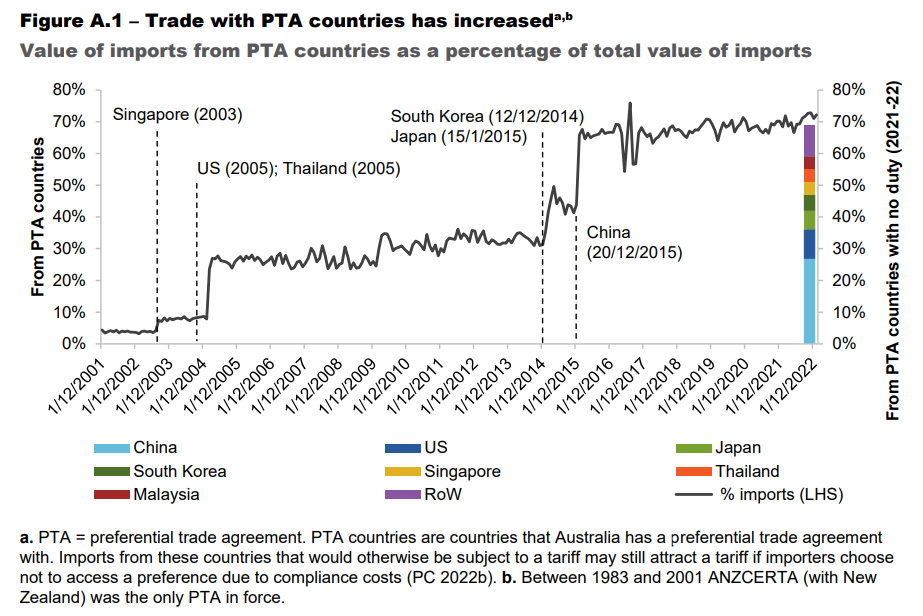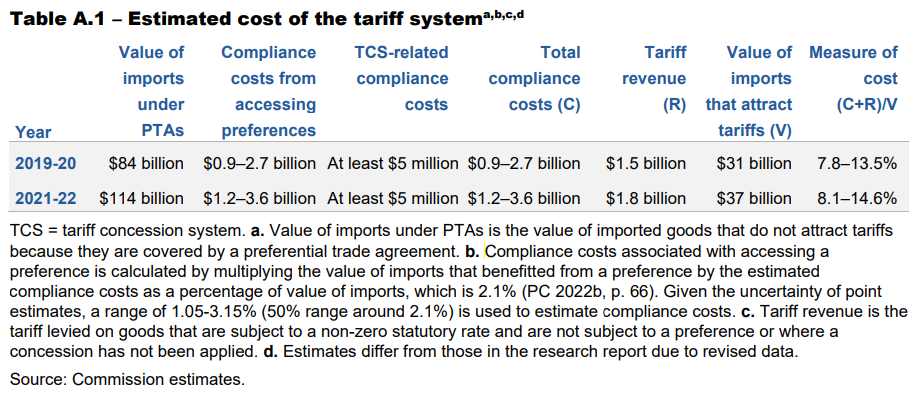Last year’s Trade & Assistance Review from the Productivity Commission (PC) explained how Australia’s system of import tariffs has become a nuisance that costs more in compliance costs than the revenue that it raises.
The PC estimated that the federal government collected $1.8 billion in tariff revenues in 2021-22, while businesses spent between $1.2 billion and $3.6 billion on complying with the tariff regime:
“Compliance costs increase as the number of preferential trade agreements increases and the system becomes more complicated”.
“The proportion of trade that qualifies for preferential treatment has expanded significantly since 2000 as the number of preferential trade agreements (PTAs) that Australia has signed has increased (figure A.1)”:

“Almost all imports from countries with which Australia has a PTA attract no tariffs, whether because the import attracts no tariff because the statutory tariff rate is zero, or because it is imported under a PTA (the column in figure A.1 account for almost all imports from PTA countries)”.
“While Australia’s tariff rates are low and only levied on a narrow range of goods, the tariff system as a whole creates costs for businesses when they pay a tariff or when they interact with the system to obtain a preference or a concession”.
“The Commission has estimated the compliance costs that businesses incurred for 2019-20 (box A.1). Using this same methodology, we estimate the nuisance cost of tariffs for 2021-22 to be between $1.2 and $3.6 billion (table A.1)”.

Treasurer Jim Chalmers has announced that the federal government plans to scrap about 500 tariffs on imported goods, which will save businesses about $30 million a year in compliance costs.
The government will target so-called ‘nuisance’ tariffs that are typically less than 2% and raise comparatively little revenue compared with the cost of administering them. They include items ranging from tampons and dodgem cars, to toothbrushes, chopsticks, power tools and white goods.
“As it stands, tariffs make these products more expensive, and cost more to administer”, Chalmers said.
“But these nuisance tariffs do nothing to protect Australian businesses and workers because they apply to goods that often arrive under a concessional rate”.
“So only on a small portion of goods, or sometimes none, is the tariff actually paid”.
“This means the government and businesses spend more administering and complying with the tariff system than we receive in revenue”, Chalmers said.
Chalmers will outline the full list of tariffs in the May budget.
This is good policy from Chalmers.
Australia has already reduced or eliminated tariffs with its numerous free trade agreement partners, resulting in efficiency distortions through trade diversion.
Tariffs on remaining items would be removed for all trading partners, thereby eliminating these distortions.
It would also cut compliance and administrative costs for businesses and the government, increasing overall efficiency.
Given that Australia no longer has a domestic car industry and the expenses of tariff collection outweigh the income gains, there is no good reason to keep these ‘nuisance’ tariffs.

